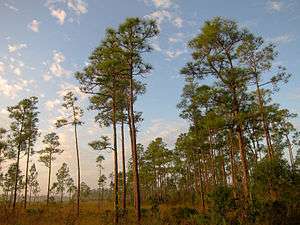South Florida rocklands
Coordinates: 25°N 81°W / 25°N 81°W
| South Florida rocklands | |
|---|---|
|
Pine rockland in the Everglades | |
 | |
| Ecology | |
| Biome | Tropical and subtropical moist broadleaf forests |
| Bird species | 176[1] |
| Mammal species | 36[1] |
| Geography | |
| Area | 2,100 km2 (810 sq mi) |
| Country | United States |
| State | Florida |
| Conservation | |
| Habitat loss | 53.93%[1] |
| Protected | 56.06%[1] |
The South Florida rocklands ecoregion, in the tropical and subtropical moist broadleaf forests biome, occurs in southern Florida and the Florida Keys in the United States, where they would naturally cover an area of 2,100 km2 (810 sq mi). These forests form on limestone outcroppings with very thin soil;[2] the higher elevation separating them from other habitats such as coastal marshes and marl prairies.[3] On mainland Florida, rocklands exist primarily on the Miami Rock Ridge, which extends from the Miami River south to Everglades National Park. South Florida rocklands are further divided into pine rocklands and rockland hammocks.[2]
Pine rockland
The pine rockland community canopy is dominated almost exclusively by South Florida slash pine (Pinus elliotti var. densa). Beneath this canopy lies a rich understory composed of grasses, sedges, palms, vines, and shrubs of temperate and tropical origin, such as broomsedge bluestem (Andropogon virginicus), coontie (Zamia integrifolia), fivepetal leaf-flower (Phyllanthus pentaphyllus), Florida bluestem (Andropogon floridanus), Florida clover ash (Tetrazygia bicolor), Florida Keys noseburn (Tragia saxicola), Pineland Snakeherb (Dyschoriste angusta), Pineland spurge (Euphorbia pinetorum), silver bluestem (Bothriochloa saccharoides), and Beyrich threeawn (Aristida beyrichiana).[4] The pine rockland community is South Florida’s most floristically diverse plant community and includes several endemic species. A subclimatic community, pine rocklands have depended on wildfire to keep them from transitioning into hardwood hammocks.
Rockland hammock
Rockland hammocks form on regions of rockland where a lack of fire has allowed hardwood trees to become dominant, nearly all of which are tropical in origin.[5] Natural firebreaks include exposed limestone cliffs and solution sinkholes.[6] Canopy species include gumbo-limbo (Bursera simaruba), paradise tree (Simarouba glauca), pigeonplum (Coccoloba diversifolia), Florida strangler fig (Ficus aurea), false mastic (Sideroxylon foetidissimum), willow bustic (Dipholis salicifolia), short-leaf fig (Ficus citrifolia), false tamarind (Lysiloma latisiliquum), West Indian mahogany (Swietenia mahagoni), and pepperleaf sweetwood (Licaria triandra). Epiphytes that grow in the canopy include Spanish moss (Tillandsia usneoides) and mall moss (Tillandsia recurvata). Plants such as black ironwood (Krugiodendron ferreum), inkwood (Exothea paniculata), lancewood (Nectandra coriacea), marlberry (Ardisia escallonoides), poisonwood (Metopium toxiferum), satinleaf (Chrysophyllum oliviforme), white stopper (Eugenia axillaris), shiny oysterwood (Gymnanthes lucida), and pale lidflower (Calyptranthes pallens) grow in the understory. Southern live oak (Quercus virginiana), a temperate species, can be found on hammock margins.[5]
Conservation
Because of its high elevation, the Miami Rock Ridge was the first area to be impacted by development. The clearing of large tracts for development have now reduced the pine rocklands to about 20,000 acres (81 km2), most of which are now protected inside the Everglades National Park. Wildfire suppression has resulted in many formerly pine rockland properties transitioning to hammock or becoming invaded by non-native invasive species, causing a net loss of biodiversity and the extinction or near extinction of several plant species.
See also
References
- 1 2 3 4 Hoekstra, J. M.; Molnar, J. L.; Jennings, M.; Revenga, C.; Spalding, M. D.; Boucher, T. M.; Robertson, J. C.; Heibel, T. J.; Ellison, K. (2010). Molnar, J. L., ed. The Atlas of Global Conservation: Changes, Challenges, and Opportunities to Make a Difference. University of California Press. ISBN 978-0-520-26256-0.
- 1 2 "South Florida rocklands". Terrestrial Ecoregions. World Wildlife Fund. Retrieved 2009-01-15.
- ↑ "Pine Rocklands" (PDF). United States Fish and Wildlife Service. Retrieved 2009-01-15.
- ↑ Whitney, Eleanor Noss; Ellie Whitney; D. Bruce Means; Anne Rudloe (2004). Priceless Florida: Natural Ecosystems and Native Species. Pineapple Press Inc. p. 106. ISBN 978-1-56164-308-0.
- 1 2 "Tropical Hardwood Hammock". The Croc Docs. Fort Lauderdale Research and Education Center. Retrieved 2009-01-15.
- ↑ "South Florida Hardwood Hammock". NatureServe Explorer. NatureServe. Retrieved 2009-01-20.
